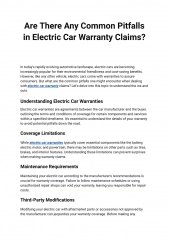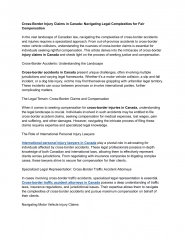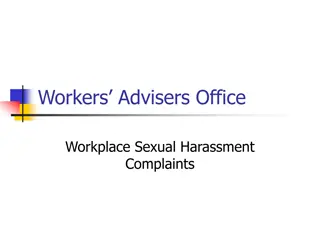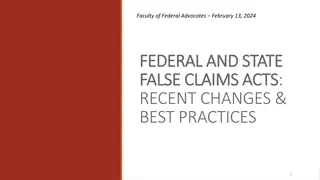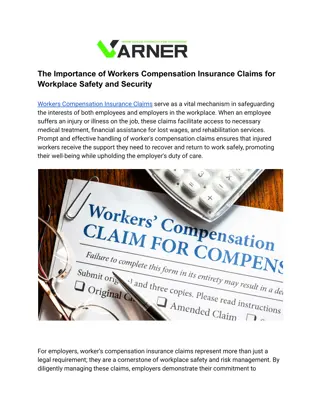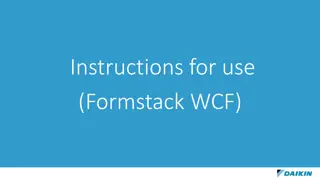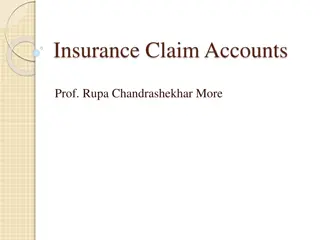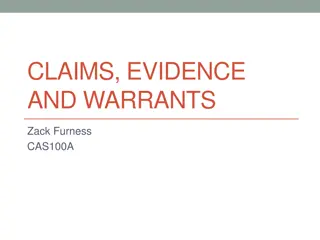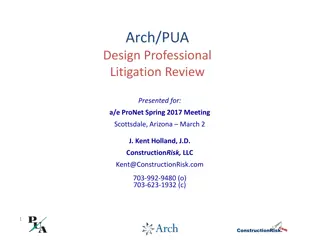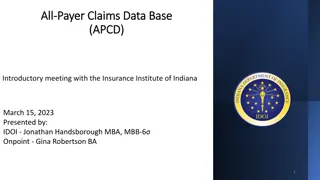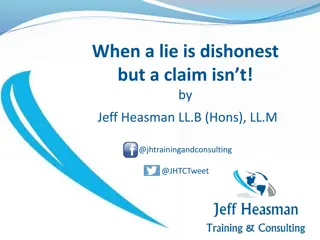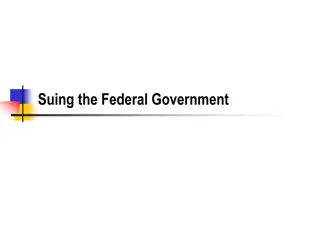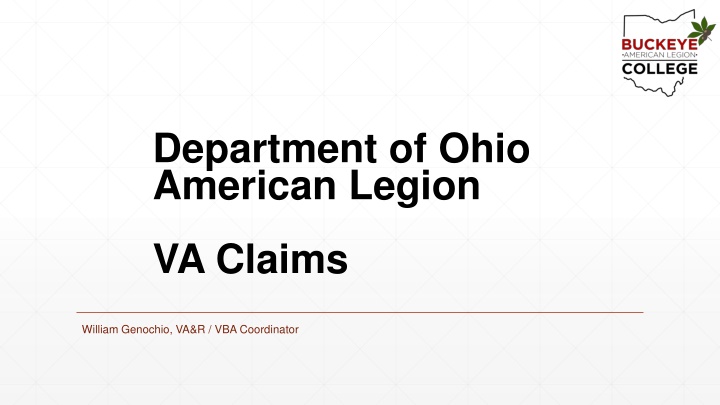
VA Claims Types and Service Connection Eligibility Guide
Learn about the different types of VA claims available, such as Initial, Increase, New, Secondary, and Supplemental claims, along with information on Service Connection eligibility criteria for VA disability benefits. Understand the process and requirements related to filing VA claims effectively.
Download Presentation

Please find below an Image/Link to download the presentation.
The content on the website is provided AS IS for your information and personal use only. It may not be sold, licensed, or shared on other websites without obtaining consent from the author. If you encounter any issues during the download, it is possible that the publisher has removed the file from their server.
You are allowed to download the files provided on this website for personal or commercial use, subject to the condition that they are used lawfully. All files are the property of their respective owners.
The content on the website is provided AS IS for your information and personal use only. It may not be sold, licensed, or shared on other websites without obtaining consent from the author.
E N D
Presentation Transcript
Department of Ohio American Legion VA Claims William Genochio, VA&R / VBA Coordinator
Learning Objectives What types of VA claims are there? The four common types of Service Connections Forms to use to start a VA claim 2
Types of VA Claims Initial Claim (original): filed when a veteran first asked the VA for service connection and compensation. Increase Claim: filed to ask the VA for an increase in already service- connected condition. New Claim: filed when new conditions = new claim. Secondary Claim: filed when a condition is caused by or linked to a service-connected condition. Special Claims: filed for special needs linked to your service- connected disabilities i.e., special adaptive auto, special adaptive housing, or temporary 100% for service-connected surgery Supplemental Claims: filed to supply new evidence for a denial received over more than one year ago.
Service Connection VA disability compensation provides tax-free monthly payments. If you have a service-connected condition, you may be eligible for compensation. A service-connected condition means an illness or injury that was caused by or became worse because of your active military service.
Service-Connection Eligibility You may be eligible for VA disability benefits or compensation if you meet both of these requirements: Both of these must be true: you have a current illness or injury (known as a condition) that affects your mind or body, and you served on active duty, active duty for training, or inactive duty training And at least one of these must be true: you got sick or injured while serving in the military and can link this condition to your illness or injury (called an in-service disability claim), or you had an illness or injury before you joined the military and serving made it worse (called a pre-service disability claim), or you have a disability related to your active-duty service that didn t appear until after you ended your service (called a post-service disability claim)
Service-Connection Eligibility Presumptively Presumptive Conditions For some conditions, we automatically assume (or presume ) that your service caused your condition. We call these presumptive conditions. If you have a presumptive condition, you don t need to prove that your service caused the condition. You only need to meet the service requirements for the presumption. Find out more about these categories of presumptive conditions: A chronic, long-lasting disability that appears within one year after discharge. These are outlined in Title 38, Code of Federal Regulations, 3.309(a) An illness by contact or exposure to contaminants (toxic chemicals) or other hazardous materials. These include but not limited Agent Orange, Blue Water Navy, and Camp Lejeune Contaminated Water. An illness caused by your time spent as a Prisoner of War (POW).
Service-Connection Types Direct Secondary Aggravation Presumptive
Service-Connection Direct Direct service connection (SC) means that a particular disease or injury was incurred in service. This is accomplished by affirmatively showing onset during service. There are three components to proving direct SC. These are 1. a current disability, 2. an event, injury, or disease in service, and 3. a link or nexus establishing that the current disability had its onset in service, which may be established by evidence of chronicity and continuity, or continuous symptoms or a medical nexus opinion.
Service-Connection Secondary You can file a secondary claim to get more disability benefits for a new disability that s linked to a service-connected disability you already have. For example, you might file a secondary claim if you: develop arthritis that s caused by a service-connected knee injury that happened while on active duty, or develop heart disease that s caused by the high blood pressure you were diagnosed with while on active duty and that we d previously concluded was connected to your service, develop residuals to certain medical conditions such as Parkinson s or Diabetes Mellitus Type II.
Service-Connection Aggravation Consider a pre-existing injury or disease to have been aggravated by active military service when there is an increase in disability during active military service, unless the evidence clearly and unmistakably shows the increase in disability is due to the natural progression of the injury or disease. In determining that the presumption of soundness has been overcome, 38 U.S.C. 1111 requires that the evidence clearly and unmistakably establishes that the disability: existed prior to service, and was not aggravated by service. When a claimed disorder was not noted on the entrance examination and the presumption of soundness applies, but evidence shows pre-existence of the claimed disability, the presumption of soundness still applies unless clear and unmistakable evidence further proves the condition was not aggravated by service. Such clear and unmistakable evidence must establish that: there was no increase in disability during service, or any increase in disability was due to the natural progression of the pre-existing condition.
Service-Connection Presumptive VA automatically presumes that certain disabilities were caused by military service. This is because of the unique circumstances of a specific veteran s military service. If a presumed condition is diagnosed in a veteran within a certain group, they can be awarded disability compensation. This includes: Former Prisoner of War, Vietnam veterans, Atomic veterans exposed to ionizing radiation, Gulf War and Post 9/11 veterans, Blue Water Navy veterans, and Camp Lejeune veterans.
How to Start a VA Claim The first step is to obtain a VA Form 21-22, Appointment of Veterans Service Organization as Claimant Representative. https://www.vba.va.gov/pubs/forms/VBA-21-22-ARE.pdf The next steps is to file the claim using VA Form 21-526EZ, Application for Disability Compensation and Related Compensation Benefits. https://www.vba.va.gov/pubs/forms/VBA-21-526EZ-ARE.pdf However, if the veteran does not have all the required documentation or diagnosis for the condition, he/she is planning to file. Therefore, submit a VA Form 21-0996, Intent to File a Claim for Compensation and/or Pension or Survivors Pension and/or DIC. https://www.vba.va.gov/pubs/forms/VBA-21-0966-ARE.pdf The intent to file serves as a place holder for one year to allow the claimant to get the needed diagnoses, documentation, or medical nexus to support the claim.
VA Appeals Options Supplemental Lane High Level Review Lane Board of Veterans Appeal Lane Direct Review, no hearing Evidence submission, no hearing Hearing with BVA Law Judge
Supplemental Lane If you have new evidence File a Supplemental Claim if you have new and relevant evidence that we didn t consider before. We can help you gather any new evidence you identify (such as medical records) to support your claim. A reviewer will decide if this new evidence changes the decision. To file a Supplemental Claim, fill out VA Form 20-0995.
Higher Level Review If you believe there s an error in your case and you don t have new evidence Request a Higher-Level Review if you believe there s an error with the decision on your claim. You can t submit any new evidence. A higher-level reviewer will review your decision again. This reviewer will consider the same evidence that you already submitted. Note: You can request an optional, one-time, informal conference with a higher- level reviewer to identify specific errors in the case. If you request an informal conference, this may delay the review. To request a Higher-Level Review, fill out VA Form 20-0996.
Board of Veterans Appeals If you want the Board of Veterans Appeals to review your case Request a Board Appeal if you want a Veterans Law Judge at the Board of Veterans Appeals to review your case. When you fill out the form, you ll need to request the type of review you want from the Board: Direct review, if you don t want to submit evidence or have a hearing Evidence submission, if you want to submit additional evidence without a hearing Hearing, if you want to have a hearing with a Veterans Law Judge (with or without new evidence) File VA FORM 10182
DSO Production YEAR RETRO REMAND TOTAL WIN PERCENTAGE 2023 $501,632.51 $85,426.25 $586,632.51 82% 2022 $2,161,012.38 $1,433,327.39 $3,594,339.77 83% 2021 2020 2019 2018 2017
Summary Six types of VA Claims Four main types of Service Connection Filing for VA Compensation
Questions William Genochio EMAIL: genochio@ohiolegion.com
Back-up Slides Text
Back-up Slides Text

